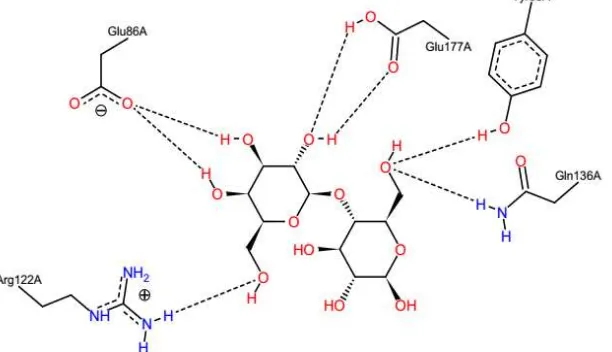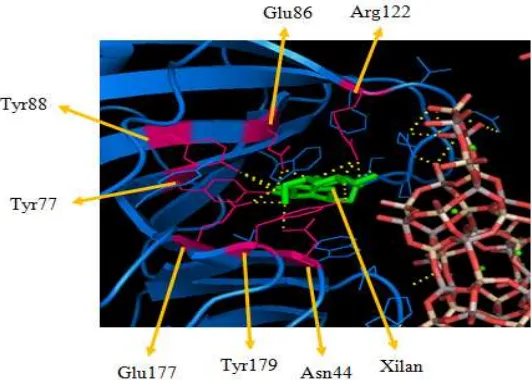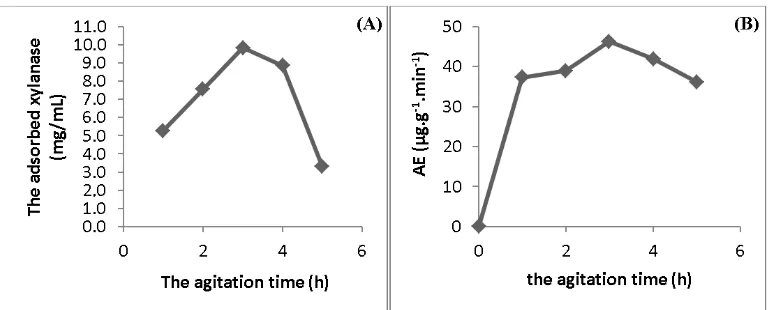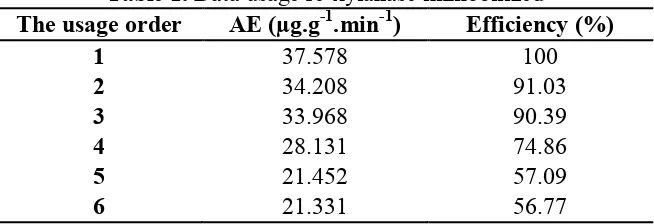The journal homepage www.jpacr.ub.ac.id p-ISSN : 2302 – 4690 | e-ISSN : 2541 – 0733
Studies of In Vitro and In Silico of Immobilized Xylanase on
Zeolite Matrix Activated with Hydrochloric Acid
Janatun Na’imah1
, Sasangka Prasetyawan1, Arie Srihardyastutie1,*
1
Chemistry Department, Brawijaya University, Jalan Veteran 65145 Malang, East Java, Indonesia
*
Corresponding email : arie_s@ub.ac.id
Received 17 April 2017; Revised 5 May 2017, Accepted 9 May 2017
ABSTRACT
Xylanase is a hydrolase enzyme that can hydrolyze hemicellulose into xilo-oligosaccharide and xylose. This research is aimed to investigate the in vitro and in silico xylanase (isolated from the fungus Trichoderma viride) immobilized on the zeolite matrix activated with HCl 0.4 M solution. The study was performed using in silico docking molecular methods to investigate the interaction between the xylanase primarily to its ligand. Xylanase activity was determined by reducing sugar produced (xylose) by 1 mL of enzyme per minute. The optimum conditions of immobilized xylanase were measured according to the time agitation and concentration of xylanase. The time variation agitation used were 1, 2, 3, 4, and 5 hours, while variations in the concentrations of a xylanase used were 11.500, 15.653, 20.444, 25.875, and 31.944 mg/mL. The optimum conditions of immobilized xylanase was obtained in the shaking time for 3 hours at a concentration of xylanase 15.653 mg/mL and immobilized xylanase activity generated at 46.755 μg.g-1.min-1. Immobilized xylanase activity was greater than the purified xylanase (15.976 μg.mL-1.min-1). These results were due to the cofactors Al (AlO4) and Si (SiO4) of zeolite was able to increase the kinetic energy caused the reaction rate between xylanase with the larger substrates. Cofactor also increased the kinetic energy and can enhance the rate of reaction between a xylanase with its substrate, in order to give greater activity. Immobilized xylanase was stable and its accelerate the rate of reaction, such as agricultural products, chemicals, and medical. Enzymes can accelerate the reaction 108-1011 times faster than the reaction without enzyme [1]. Enzymes work by speeding up reactions without altering the equilibrium of chemical reactions that occurred. Mechanism of the enzyme occurs when the enzyme binds to its substrate in the enzyme active site, it will form enzyme-substrate complex which is short-lived, and the enzyme will released after the product has been formed.
places, can grow rapidly on a variety of substrates, and are able to breed in conditions of acidic pH (2.1 to 2.5) [5], period of cultivation at 96 hours, optimal temperature at 25 oC, and viability of biomass at 6-7 months [6]. Xylanase is an inductive enzyme, enzyme that needs an inducer in order to work properly, i.e. xylan (hemicellulose) [7].
The free enzyme can only be used once, it is important to enhance the efficiency of the use of enzymes and can be used repeatedly, i.e. immobilization that can be used repeatedly [8]. The advantages of immobilized enzymes include enzymes can be separated from the reaction mixture quickly, thereby minimizing or eliminating protein contamination of the product. Immobilization also facilitates the efficient recovery and reuse of costly enzymes, and its application in the industry can lower operating costs [9].
In this study, xylanase was immobilized on zeolite matrix using physical adsorption method. Natural zeolites contain the main components of silica and alumina. In addition, it is also contain various minor elements, such as Na, K, Ca [10], Mg, dan Fe [11]. Zeolite was activated first through with two stages, the chemical addition of 0.4 M HCl solution, and calcination. There are several factors that affect the enzymatic reactions, such as agitation times and enzyme concentrations. Increasing the agitation times and enzyme concentrations can increase the xylanase activity. A study from Sari, 2014 has reported that the optimum condition of Trichoderma viride xylanase immobilized with zeolite in the agitation times 3 hours and xylanase optimum concentration of 3.366 mg/mL by the number of adsorbed xylanase activity as much as 15.65 mg and 25.74 units [12].
Xylanase-xylan complexes formed the xylose product due to xylan was bounded on the active side of a xylanase. Therefore, it is necessary to investigate the interaction between the xylanase with xylan, xylanase with zeolite, also xylanase with xylan and zeolite. The process is molecular docking method, which is used molecular modeling as a scientific justification or predicts the biological activity of a compound in silico. In silico method is performing by simulation of the interaction between the active site of the protein receptor ligands. The ligands used are xylan and zeolite. Protein receptors used were xylanase from Trichoderma viride obtained from RCSB Protein Data Bank. Method of molecular interaction modeling with receptor using an AutoDock based on the docking process was developed to look for the active site of entire surface of the receptor protein and also optimize its peptide conformation. Protein used is not contains ions, water molecules, and other substances beside protein. The interaction energy between the ligand and the receptor is influenced by different types of atomic parameters, including hydrogen bonding donor, hydrogen bonding acceptor, and non-polar atom, such as carbon. Conformation analysis using AutoDock is more commonly used because of its strong ability in searching conformation of compounds used [13, 14]. In vitro study was conducted by immobilization of xylanase with zeolite matrix at their optimum conditions, and testing the efficient use of the immobilized xylanase.
EXPERIMENT
Chemicals and instrumentation
source of xylanase was Trichoderma viride obtained from Microbiology Laboratory, Department of Biology, Faculty of Science University of Malang, in East Java. Material used in this research such as sodium phosphate (Na2HPO4), potassium dihydrogen phosphate
(KH2PO4), calcium chloride (CaCl2), Ammonium sulphate ((NH4)2SO4), magnesium sulfate
heptahydrate (MgSO4.7H2O), dinitrosalisilic acid (DNS), 10% sodium hydroxide (NaOH),
NaKC4O6H4, copper sulfate pentahydrate (CuSO4.5H2O), glacial acetic acid, sodium acetate
(CH3COONa), hydrochloric acid (HCl) 0.4 M and 0.1 M, 0.1 M barium chloride (BaCl2),
anhydrous glucose, microscopic elements, oleic acid, dextrose, urea, peptone, bacto agar, xylan, zeolite, and casein, a cellophane membrane, potatoes, corn husks, and aquadest.
Procedure
Xylanase used in this study were isolated from Trichoderma viride purified by fractionation (0-40% and 40-80%) and dialysis using a cellophane membrane. In vitro studies conducted in two stages, firstly, the determination of optimum conditions of immobilized xylanase and the efficiency of reusability in the immobilized xylanase. In silico research was conducted by using software Autodock Molecular Docking Vina (PyRx 0.8). Macromolecule used was a xylanase, while the ligand was xylan and zeolite.
Determination of Optimum Condition immobilized xylanase
0.1 grams of zeolite matrix activated by 0.4 M HCl was treated by mixing 2 mL of purified xylanase and acetate buffer solution pH 6 until the volume of 5 mL. Then, the mixture was washed by aquadest and evaporated. After that, it incubated using a shaker (100 rpm) at room temperature with a variation of 1, 2, 3, 4, and 5 hours. Furthermore, the mixture filtered by the paper Whatman 40 obtained filtrate and precipitate. The enzyme activity of filtrate was tested while precipitate was analyzed its residual protein.
Optimization of xylanase concentration variations was conducted by optimizing stages agitation time variation. Xylanase concentration used was 11.500, 15.653, 20.444, 25.875, and 31.944 mg/mL. Then, it incubated for optimum agitation time that has been done previously using a shaker with a speed of 150 rpm. Furthermore, it filtered with paper Whatman 40 in order to obtain filtrate and precipitate. The enzyme activity of filtrate was tested, while precipitate was analyzed its enzyme activity.
The efficiency of reusability in the immobilized xylanase
The immobilized xylanase put into the first test solution, and then the precipitate filtered with paper Whatman 40. The obtained precipitate put into the next test solution under the identical conditions. This treatment was repeated 6 times. The obtained filtrates in each test were used to test the activity by adding 0.4 mL of DNS reagent and heated in boiling water bath for 15 minutes. Furthermore, the solution was cooled to room temperature and measured its absorbance at 490 nm wavelength.
Docking process
RESULT AND DISCUSSION
Molecular Docking is a method to determine the interaction of macromolecules with ligands in silico. Xylanase and xylan macromolecular ligands downloaded as a 3D structure of GDP RCSB with code 3AKT and 1KNM. Xylanase and xylan were optimized using PyMOL and obtained conformation of xylan with the geometric structure of the most stable. The docking process performed by software PyRx and Patch Dock. Xylanase activity obtained by purification of 15.976 μg.mL-1.min-1 with the protein content of 12.778 mg. The interaction between the xylanase with xylan will produce xylose which is a reducing sugar. Interactions occurred in hydrogen bonds linking between xylan with amino acids Glu86A, Glu177A, Tyr88A, Gln136A, Arg122A. The docking process also obtained ΔG value of -7.1 kcal/mol and 1.752 Å RMSD value. If the value of RMSD ≤ 2, the position is similar to the native ligand copy ligand, so the docking valid method used to predict the interaction of xylanase to xylan. Moreover, it also acquired some parameters using Molecular Docking Server, such as ΔG -1.98 kcal/mol; ki 35.11 mM; electrostatic energy -0.31 kcal/mol; total
energy of intermolecular -5.41 kcal/mol; vdW + H bond + bond desolvation -5.10 kcal/mol; and a frequency of 70%.
Figure 1. Interaction between active site of xylanase with xylan
At the stage of immobilization xylanase with zeolite obtained the immobilized xylanase activity at 46.755 μg.g-1.min-1 and contain a protein content of 0.589 mg. The immobilized xylanase activity was greater than the xylanase obtained from purification. This is due to the cofactors Al (AlO4) and Si (SiO4) of zeolite that can supply and modify the structure of a
xylanase, so that the xylan substrate can easily interact with. In addition, the kinetic energy will be increased to speed up the rate of reaction between a xylanase with xylan, so as to obtain greater activity. The docking process between a xylanase, zeolite, and xylan showed that there was no interaction between xylan and zeolite. Interactions occurred in the hydrogen bonds linking between macromolecules xylanase amino acid Asn44, Tyr77, Glu86, Tyr88, Asn122, Glu177, and Tyr179 with ligands xylan. In addition, the hydrogen bonds also connect between the O atoms of the zeolite with xylanase amino acid Asn124, His22, and Gln125. Gln125 amino acid binds to two O atoms of the zeolite, i.e. the atoms O (SiO4) and
O atoms (AlO4). The parameters were ΔG value exhibited -32.79 kcal/mol ; attractive Vdw of
Figure 2. The interaction between xylanase of amino acid Gln125 with (a) O (SiO4) zeolite
and (b) O (AlO4) zeolite
Figure 3. The interaction between xylanase with zeolite, (a) Asn124 with O (AlO4) and (b)
His22 with O (SiO4)
Figure 4. The interaction between xylanase with xylan in the xylanase-zeolite-xilan complex
Optimization of a xylanase Optimum Condition
Time agitation during immobilization affected the rate of diffusion of xylanase to the matrix. Increasing the agitation time affected the increasing rate of diffusion to reach adsorption equilibrium. The increase in the diffusion rate can increase the amount of xylanase adsorbed by the matrix until it reaches a saturation point, i.e. the point when the adsorption rate equal to the rate of desorption. The results showed that the amount of adsorbed xylanase has increased for 1 to 3 hours. This was due to the high probability of contact between the xylanase with zeolite, so the higher amount of a xylanase that attach to the surface of the zeolite until it reaches equilibrium time. Decrease the amount of xylanase adsorbed on the 4th and 5th hour may be due to agitation time too long so that the amount of xylanase on the surface of the zeolite took off. This is due to weak bonds between xylanase with zeolite. The resulting optimum agitation time was 3 hours with xylanase amount adsorbed matrix and maximal activity of 9.848 mg and 46.273 μg.g-1.min-1, respectively.
Figure 5. Plot of the agitation time vs: (a) the adsorbed xylanase with zeolite dan (b) the
immobilized enzyme activity
Figure 6. The plot of xylanase concentration vs: (a) the adsorbed xylanase and (b) the immobilized enzyme activity
Efficient utilization of the immobilized xylanase
Efficient utilization of immobilized xylanase performed at the optimum condition when agitation for 3 hours and the enzyme concentration of 15.653 mg/mL. This stage was carried out to determine the use of a xylanase which can be used repeatedly. The increasing quantity of immobilized xylanase can debilitate its activity, due to lower the bonding force of physical adsorption between xylanase and xylan, therefore reduced the xylose amount. It had similar effect with the efficient use of the protein content of immobilized xylanase produced (10.356 mg). The results showed that the activity of the immobilized xylanase was stable after repeated by 6 times, which was resulted 21.331 μg.g-1.min-1 in a percentage of 57%. The stability of the activity was due to the percentage of efficiency above 50% of the activity of the first repetition.
Table 1. Data usage re-xylanase immobilized
The usage order AE (µg.g-1.min-1) Efficiency (%)
1 37.578 100
2 34.208 91.03
3 33.968 90.39
4 28.131 74.86
5 21.452 57.09
6 21.331 56.77
CONCLUSION
In vitro method resulted in the optimum conditions of immobilized xylanase were obtained at the agitation times for 3 hours with xylanase concentration of 15.653 mg/mL. Xylanase immobilized on HCl-activated zeolite can be used up to six times, with the activity of 21.331 μg.g-1
.menit-1 and efficiencies 56.77%.
In silico method afford the interaction between the xylanase-xylan-zeolites are linked by hydrogen bonds. Complex interactions-xylan xylanase is a xylanase xylan binds to amino acid residues Glu86A, Glu177A, Tyr88A, Gln136A, Arg122A. While the complex interactions xyanase-zeolite is the O atom of zeolite (AlO4 and SiO4) binds with Asn, Glu,
and His. The interaction between xylanase, xylan, and zeolites are linked by hydrogen bonds that linking to Asn124, His22, and Glu125 with O atoms of AlO4 and SiO4 zeolites, as well as
References
[1] Poedjiadi, A. dan Supriyanti F. M. T., Dasar-Dasar Biokimia, 2006, UI-Press, Jakarta. [2] Konanki, S., Jayasimha. R. D., Anitha. S. and Muralidhararao. D., IJPAES, 2013, 4(10),
19–24
[3] Richana, N., T. Irawadi, N. Anwar dan K. Syamsu, Jurnal Agro Biogen, 2008, 4(1), 24-34.
[4] Megazyme, endo-1,4-β-xylanase M1 (from Trichoderma viride) (20502), http://secure.megazyme.com/files/BOOKLET/E-XYTR1_020502_DATA.pdf, 2009, accessed date : 5 April 2016.
[5] Nurlaili, N., Uji Biologis Bungkil Biji Jarak Pagar (Jatropha curcas L.) yang Diolah dengan Ekstrak Metanol dan Fermentasi menggunakan Rhizopus oryzae serta Trichoderma viride pada Ayam Broiler, Skripsi, Departemen Ilmu Nutrisi dan Teknologi Pakan Fakultas Peternakan IPB, Bogor, 2009.
[6] Eugenia, Sesan T. and Oancea F., J. Plant Develop., 2010, 17, 49-62.
[7] Widjaja, S., T. Purwadaria dan P.P. Ketaren, Microbiol Indones, 2008, 2, 44-48. [8] Hiratsuka, A., Fujisawa K., and Muguruma H., Anal Sci, 2008, 24, 483–486. [9] Sheldon, Roger A., Adv. Synth. Catal., 2007, 349, 1289-1307.
[10] Akimkhan, A. M., Structural and Ion-Exchange Properties of Natural Zeolite, Lisence in tech, 2012, pp. 261-282.
[11] Bogdanov, B., D. Georgiev., K. Angelova,.and Y. Hristov, Synthetic Zeolites and Their Industrial and Environmental Applicat Ions Review. International Science conference. Volume IV Natural & Mathematical science, 2009.
[12] Lailah, N., Prasetyawan, S., and Srihardyastutie, A., J. Pure App. Chem. Res., 2017,
6(2), 150-159.
[13] Noolvi, M. N., and Patel, H. M., J. Saudi Chem. Soc., 2013, 17, 361 – 379.



